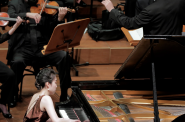Music For Watching Aliens
Milwaukee Symphony plays entire score of ‘E. T. the Extra-Terrestrial’ with the movie.
Originally conceptualized as a horror film, Steven Spielberg’s much-loved movie E. T. the Extra-Terrestrial was released in 1982. The film plays with the idea of alien invasions and is regarded as a complement to Spielberg’s Close Encounters of the Third Kind (1977). The endearing tubular alien that children name E. T. comes in peace and easily adapts to life in a suburban neighborhood. John Williams’ soundtrack for E. T. won the Academy Award for best original score, as well as a Golden Globe, BAFTA, and Grammy.
The Milwaukee Symphony Orchestra will perform the soundtrack live during a screening of E. T. on December 30 and 31 at the Marcus Center, with Yaniv Dinur conducting. The film is approximately 2 hours in length.
“I had known the wonderful music for E. T. for a long time before I actually saw the movie,” Dinur says. “To be honest, I only watched E. T. for the first time a few weeks ago to prepare for this concert. Somehow, I missed it in my childhood. So the music happened to take a more substantial place in my personal experience than the movie itself, and that’s exactly what we’re aiming for in this concert. I did tear up at the end, though.”
The story of the lonely alien botanist stranded on earth is told from a child’s point of view and highlights children’s capacity for love and acceptance. The diminutive E. T. is as knotted as the roots he collects. Spielberg said, “I really wanted E. T. to sneak up on you–not in the easy way of an F. A. O. Schwarz doll on the shelf.”
“John Williams has the ability to capture the essence of a character or a certain mood in a few measures of music. In this sense, his music is very operatic, and much influenced by the ideas of Wagner about leitmotivs, where every character has its own specific music,” Dinur points out.
The opening theme, known as the “wonder theme,” represents the small alien’s visit to a vast redwood forest, where he becomes dazzled by the natural world on earth. The flute plays a wistful melody at the start of the sequence, which becomes associated with E. T. throughout the film. Williams frequently uses the harp to represent enchanted encounters between the alien and children. On the other hand, faceless government officials who pursue E. T. are signaled by the sinister bass clarinet with a theme very much like the “Imperial March” from Star Wars.
Perhaps the best known theme in the film is “Flying,” which shows the magic of E.T’s otherworldly powers, as well as his special relationship with his human friend Elliott. (For those who haven’t noticed, the E and T of Elliott’s name are parallels of the alien’s abbreviated E. T. and the two characters have a psychic connection.) Williams celebrates the moment when the alien propels Elliott’s bicycle into the sky with a luminescent melody for the full orchestra.
YouTube: An analysis of the opening sequence of E. T. the Extra-Terrestrial with score reduction.
One of the major aspects of putting on this show is the considerable technical work of preparing the conductor’s score and a special print of the movie in which the music is removed, while dialogue and sound effects remain.
Dinur will conduct from the score and also watch a monitor at the podium. Before Dinur gets the score, it has been coordinated with a copy of the film through a system of visual cues called “streamers” and “punches.” Streamers appear on the monitor as thick, color-coded vertical lines that pass from left to right over the screen. A punch is a circle that appears when the streamer has crossed to the right side of the monitor, and coincides with a cut or a “hit” in the score. A hit point is a specific moment that is amplified by music. There are plenty of hit points in the scene when E. T. discovers and downs a six pack of beer, then bounces off the walls when he attempts to walk.
“It’s a special skill that takes some practice,” says Dinur. “It’s hard because you don’t have much freedom, but it’s a challenge that can be a lot of fun. Especially if I manage to hit everything right, like: ‘Yes! We played that chord exactly when he jumped on the car!’”
YouTube: How punches and streamers work
Dinur notes, “Movies can have a big impact on you, but they all lack something that other art forms like plays and concerts have: live action. By playing the music live with the movie, we provide an extra dimension, and therefore, a more powerful experience.”
E. T. the Extra-Terrestrial will be screened with live orchestra at 7:30 p.m. Saturday, December 30 and 2:30 p.m. on Sunday, December 31. Tickets are available from theMarcus Center for the Performing Arts by calling 414-273-7206.
Preview
-
PianoArts Festival Features Rising Stars
 May 28th, 2024 by Michael Barndt
May 28th, 2024 by Michael Barndt
-
Four Nations Ensemble Goes For Baroque
 May 13th, 2024 by Michael Barndt
May 13th, 2024 by Michael Barndt
-
Mozart on Prospect Avenue
 May 9th, 2024 by Martha Brown
May 9th, 2024 by Martha Brown





















